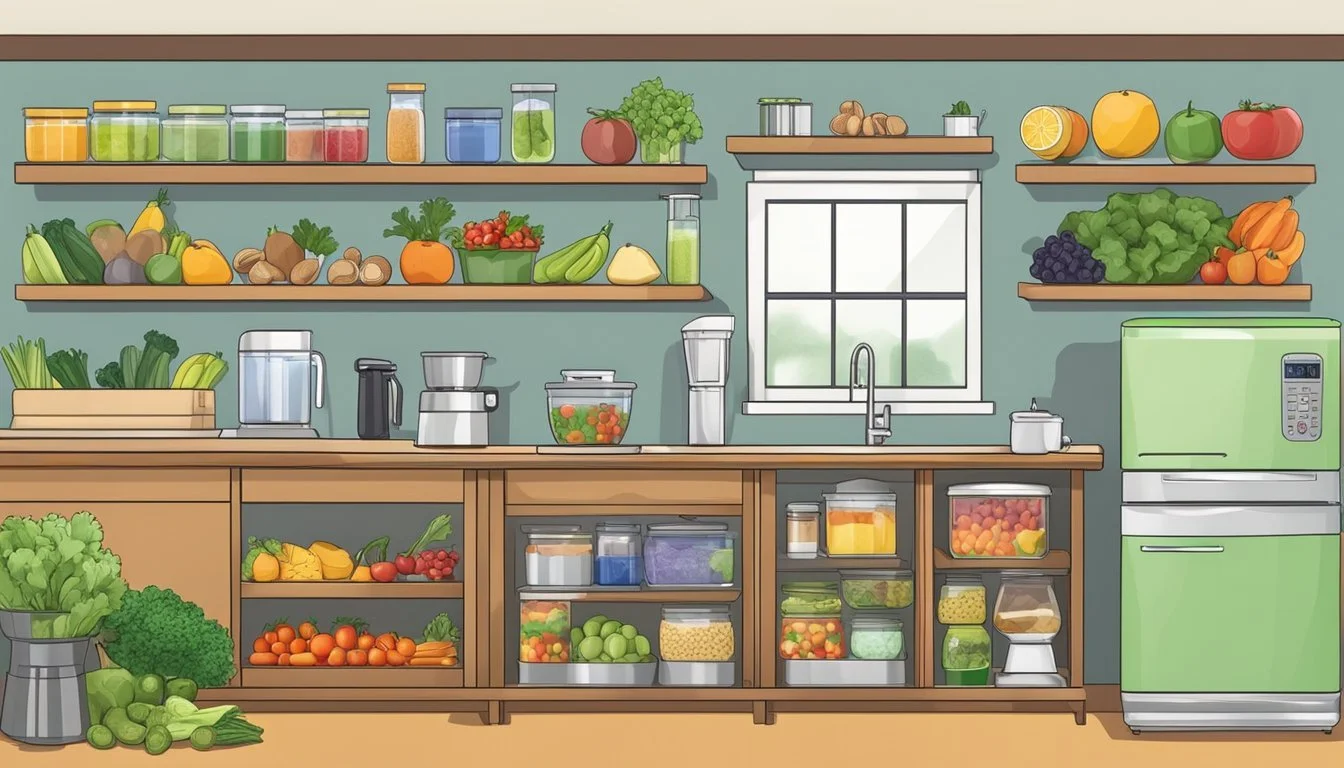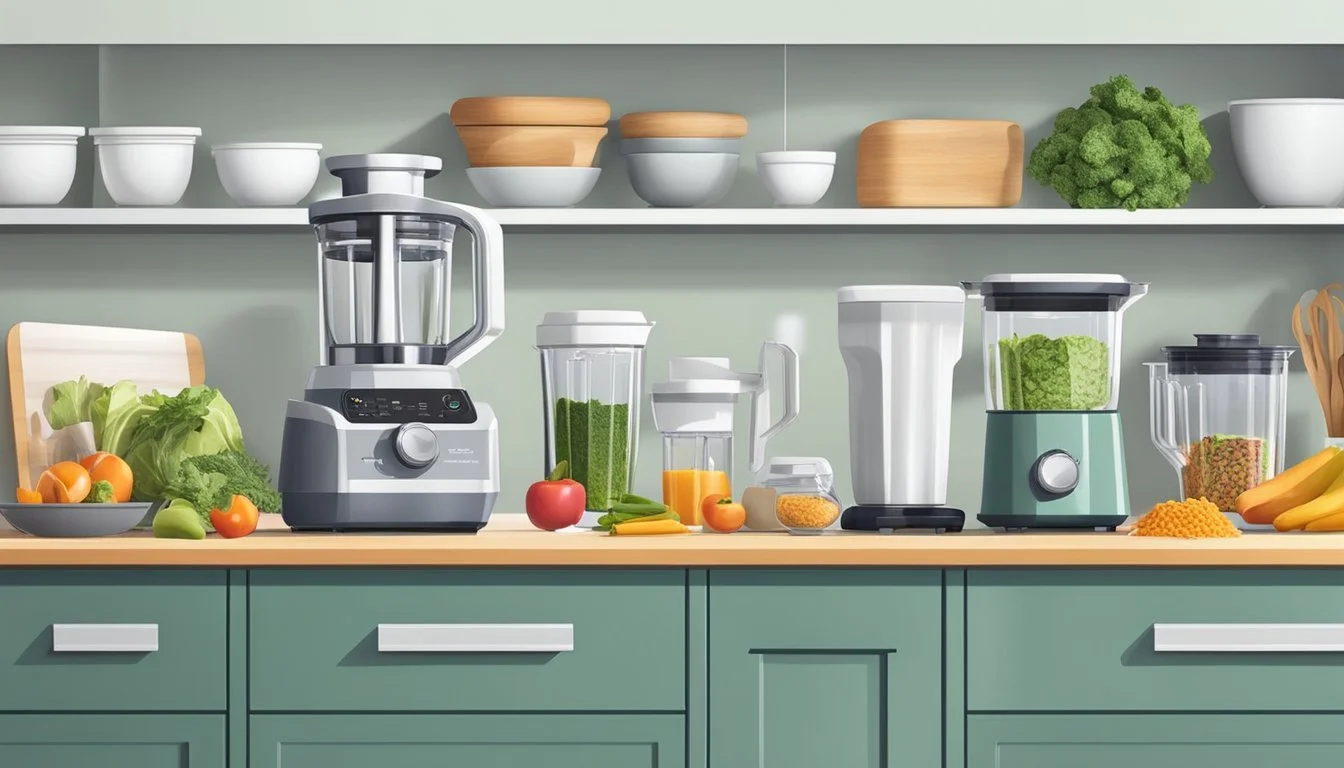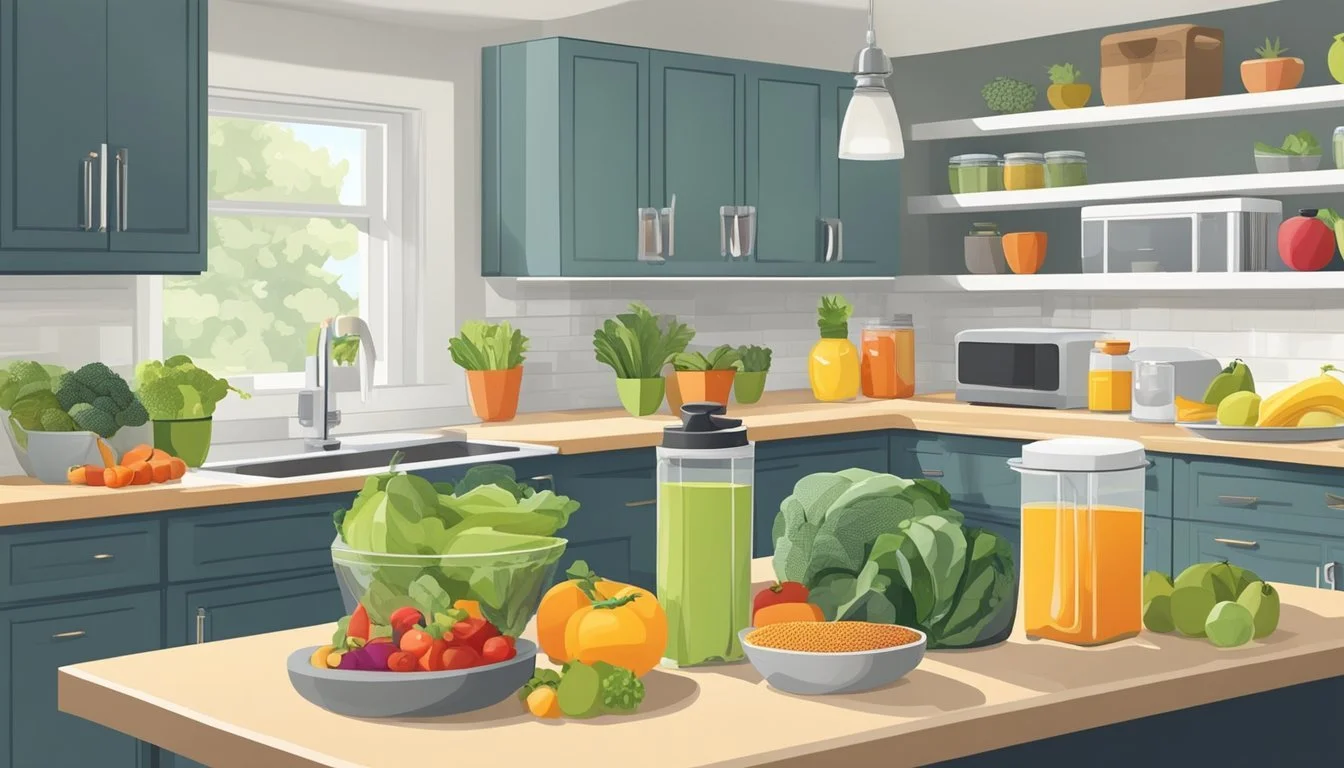How to Organize Your Kitchen for a Raw Food Diet
Essential Tips for Efficiency
Organizing a kitchen for a raw food diet is a step towards adopting a lifestyle centered on healthy eating. A raw food diet consists mainly of unprocessed, uncooked plant foods, such as fruits, vegetables, nuts, and seeds. Proponents of the lifestyle often experience an increase in energy, improved skin health, and overall well-being. To facilitate this dietary approach, the kitchen must be tailored to support the unique requirements of preparing and storing raw foods.
Efficient storage and accessibility play crucial roles in maintaining a raw food kitchen. Clearing the space of unnecessary items and equipping it with the right tools such as high-quality knives, a blender, food processor, and dehydrator can streamline the food preparation process. It is also beneficial to have an array of glass jars and containers for soaking nuts and seeds, as well as storing sprouts and prepared salads.
Maintaining an organized pantry with a dedicated space for whole, raw ingredients encourages healthy choices and simplifies meal planning. By placing fruits, vegetables, and other raw food staples within easy reach, individuals are more likely to select these items, making it effortless to adhere to a raw food diet. With a well-arranged kitchen environment, anyone can take positive steps towards improved health and vigor.
Understanding the Raw Food Diet
The raw food diet emphasizes the consumption of unprocessed, whole plant-based, and ideally organic foods. This diet often contains foods that have not been heated above a certain temperature, usually around 116 to 118 degrees Fahrenheit, to preserve nutrients and enzymes.
Benefits of a Raw Food Diet
Improved Health: Indulging in a raw food diet promotes eating an abundance of fruits and vegetables, which are key sources of essential vitamins and minerals.
Increased Energy: Many individuals report a boost in energy levels due to the high nutrient content in raw foods.
Natural Weight Loss: A raw diet often has a lower calorie density and higher fiber content, which can lead to weight loss.
Clear Skin: The fresh produce and healthy fats consumed in this diet contribute to better skin health.
Key Nutrients in a Raw Food Diet
Vitamins and Minerals: A wide variety of fruits, vegetables, nuts, and seeds provides a spectrum of vitamins and crucial minerals.
Healthy Fats: Nuts and seeds, along with avocados and coconuts, are sources of healthy fats essential for optimal body function.
Common Raw Food Diet Mistakes to Avoid
Nutrient Deficiencies: Without careful planning, one might miss out on important nutrients such as protein, iron, calcium, and B12.
Overconsumption of Fats: Some individual's lean too heavily on nuts and seeds, which can lead to an imbalance in the diet.
Not Eating a Variety: Limiting the range of foods consumed can prevent the intake of essential nutrients.
Essential Kitchen Setup
When adopting a raw food diet, the organization of one's kitchen is pivotal. Proper setup of appliances and storage can minimize clutter and streamline the preparation process.
Choosing the Right Appliances
For those on a raw food diet, a high-speed blender and a food processor are indispensable tools. They must be both powerful and easy to clean. A dehydrator can also be important for creating dried fruits, veggie chips, and raw food crackers. Consider a juicer for making fresh juices; masticating juicers preserve nutrients effectively.
High-speed Blender: Ideal for smoothies and nut butters.
Food Processor: Chops and dices for salads and salsas.
Juicer: Extracts juice from fruits and vegetables, maintaining nutritional integrity.
Dehydrator: Preserves and prepares raw foods with low heat.
Storage Solutions for Fresh Produce
Fresh produce is central to a raw food diet and requires accessible and proper storage to maintain freshness. Utilize a combination of the fridge for perishables and countertop storage like a fruit bowl for items best kept at room temperature.
Refrigerator: Allocate sections for greens, fruits, and vegetables to maintain order.
Glass Jars: Ideal for storing pre-prepped ingredients and small snacks.
Fruit Bowl: Keeps frequently used fruits within arm’s reach.
Selecting Knives and Cutting Boards
Sharp knives are essential for efficient preparation of raw foods, from dicing vegetables to slicing fruits. A variety of sizes suits different tasks: a chef's knife for general use, a paring knife for smaller items, and a serrated knife for bread and tomatoes. Pair these with durable cutting boards—one for fruits, one for vegetables, and another for nuts and seeds to prevent cross-contamination.
Knives: Diverse selection for precision and ease.
Cutting Boards: Separate for each food type, preferably made of bamboo or wood to reduce wear on knives.
Organizing for Efficiency
Efficient kitchen organization is crucial for a raw food diet to ensure easy access to a variety of fresh produce and nuts while maintaining a clutter-free environment that encourages healthy habits.
Creating a Functional Pantry
Organizing the pantry starts with clear glass jars and BPA-free storage containers, which are ideal for the visibility and freshness of nuts, seeds, and superfoods like chia seeds. Items should be grouped by type and frequently used items placed at eye level. One can create sections for different categories:
Dry Goods: Almonds, walnuts, and sunflower seeds.
Superfoods: Chia seeds, hemp seeds, and flaxseeds.
Snacks: Dried fruits, raw crackers.
Labels are essential to keep track of contents and expiration dates, especially for organic, perishable items.
Strategic Fridge Layout
A raw food kitchen benefits from a fridge organized to preserve the optimal freshness of produce. Use baskets or modular fridge bins to group like produce:
Greens: Kale, spinach, and arugula placed in the crisper.
Fruits: Apples, berries, and citrus fruits in a separate section.
Prepped Produce: Washed and sliced veggies in clear containers for easy access.
It is advisable to place ripe fruit on the top shelf where it's visible. This adheres to the "out of sight, out of mind" principle, making it less likely that food is forgotten and spoiled.
The Art of Decluttering Workspaces
Decluttering kitchen workspaces is important for maintaining the focus on food choices and preparation. Countertops should only house appliances that are used daily, like a blender or food processor. Here's how to declutter efficiently:
Remove: Non-essential decorative items or rarely used equipment.
Rehome: Store infrequently used appliances in cabinets or on high shelves.
A key aspect is to create a designated space for meal prep that's always clear and ready for use, thus minimizing disruptions during the cooking process.
Selecting and Preparing Raw Foods
In the realm of raw food diets, the focus is on consuming foods in their most natural state. This section is dedicated to guiding enthusiasts on how to select the best produce for health and taste, as well as preparing these fresh foods to create nutritious and appetizing meals.
Choosing Fresh and Organic Options
For optimal health benefits, one should prioritize fresh and organic produce. Organic options are cultivated without synthetic pesticides or fertilizers, which aligns with the principles of healthy eating. When selecting fresh fruit and vegetables, look for vibrant colors and firm textures, indicators of nutrient-rich and flavorful produce. It's vital to ensure a range of fruits and leafy greens, as they are foundational to a raw food meal plan. Here is a list of suggestions:
Leafy Greens: kale, arugula, spinach
Vegetables: bell peppers, cucumbers, celery
Fruits: apples, berries, citrus fruits
Prepping Vegetables and Fruits
Proper preparation maintains the integrity of the food's natural state. Washing vegetables and fruits thoroughly is crucial to remove any residues. For vegetables like celery and carrots, this may involve peeling or trimming to remove any non-edible parts. Fruits may require careful slicing to retain the most nutritional value. Always use sharp knives and appropriate cutting boards to guarantee clean cuts and to prevent cross-contamination.
Making Raw Food Meals and Snacks
A raw food diet thrives on creativity and diversity. Designing a meal plan encompassing breakfast, lunch, dinner, and healthy snacks ensures balanced nutrition throughout the day. Avocados can be the base for savory spreads or dressings, while nuts and seeds can be soaked or sprouted to enhance their digestibility and nutritional value. Here's a simple structure for raw meals:
Breakfast: Fruit salad with a variety of seasonal fruits and a drizzle of raw honey
Lunch: Zucchini noodles with a cashew-based sauce and topped with cherry tomatoes
Dinner: Hearty salad with mixed greens, sliced peppers, and an avocado dressing
Dessert: Raw energy balls made from dates and almonds
Snacks: Sliced cucumbers with hummus, or apple slices with almond butter
Preparing these meals ahead of time contributes to the success of adhering to a raw food diet.
Planning Your Raw Food Menu
To adopt a raw food diet, one must prioritize meal structure centered around fruits, vegetables, nuts, and seeds. A well-organized menu aids in maintaining balanced nutrition and minimizing food waste.
Building a Balanced Meal Plan
When creating a meal plan for a raw food diet, it's essential to ensure that all meals are nutritionally balanced. Protein sources should come from plants, like nuts and seeds, which are also excellent for making seed crackers and sauces.
Weekday Meal Plan Example
Breakfast: Green smoothie with spinach, banana, and flaxseeds
Lunch: Mixed salad with sprouted lentils and avocados
Dinner: Zucchini noodles with cashew pesto sauce
Quick and Easy Raw Recipes
A repertoire of simple recipes ensures healthy eating without spending too much time prepping.
Breakfast
Smoothies: Blend a variety of fruits with water, coconut water, or almond milk.
Puddings: Combine chia seeds with plant milk and leave to set overnight.
Dinner
Salads: Toss a variety of leafy greens with colorful vegetables and a homemade dressing.
Noodles: Spiralize zucchini or carrots and top with a sauce made of blended raw vegetables and herbs.
Snacking Strategically
To avoid food waste, one can prepare a grocery list specifically for healthy snacks that are easy to portion and store.
Nuts and Seeds: Keep a variety of almonds, cashews, and pumpkin seeds on hand for a quick snack.
Dried Fruit: Portion control is important since dried fruits are high in sugar.
By planning strategically, one can follow a raw food diet that's both satisfying and nourishing.
Specialized Raw Food Equipment
Preparing a raw food kitchen involves selecting equipment that enhances the preparation of fruits, vegetables, nuts, and seeds. It's crucial to incorporate tools that can maintain the integrity of raw foods while creating versatile and creative dishes.
The Role of Dehydrators and Spiralizers
Dehydrators play a pivotal role in a raw food kitchen, allowing individuals to preserve fruits, vegetables, and herbs while retaining nutritional value. For instance, a dehydrator can create an array of snacks such as fruit leathers, vegetable chips, and raw bread or crackers without high temperatures that might destroy vital enzymes.
Dehydrators Benefits Preserve Foods Keeps a high level of nutrients and enzymes. Enhance Flavors Concentrates flavors naturally, without additives.
Spiralizers are another go-to appliance, as they transform raw vegetables into noodle-like strands, ideal for salads and raw pasta dishes. With a variety of blade options, they offer a breadth of textures and shapes to keep meals interesting and enjoyable.
Must-Have Gadgets and Utensils
Every raw food kitchen benefits from an arsenal of gadgets and utensils that facilitate food prep. These might include:
Sharp knives: Essential for efficient cutting and slicing of fruits and vegetables.
Cutting boards: Provide multiple surfaces for different types of foods to avoid cross-contamination.
Glass jars: Ideal for storing sprouted grains, nuts, and seeds.
Tongs and rubber spatulas: Assist in mixing salads and transferring food while avoiding damage to the food's structure.
Grinders (spice and coffee): Useful for grinding spices, seeds, and nuts to elevate the flavor profile of dishes.
The presence of a slow cooker might seem counterintuitive in a raw kitchen; however, it can keep food at a temperature below standard cooking levels, preserving raw qualities while warming some ingredients to enhance digestibility and taste. When choosing appliances, quality and durability are critical factors, as one often uses these tools frequently in the preparation of raw foods.
Maintenance and Safety
To facilitate a raw food diet, maintaining a clean and safe kitchen is crucial. This entails both a hygienic environment and proper care of the specialized equipment used in raw food preparation.
Keeping Your Kitchen Clean and Safe
A kitchen serving a raw food diet should follow rigorous cleaning protocols to prevent foodborne illnesses. Surfaces that come into contact with raw food must be sanitized regularly. One should:
Cleaning Schedule:
Daily: Wipe countertops with hot soapy water. Disinfect cutting boards and knives after each use.
Weekly: Deep-clean appliances and scrub sink with a disinfectant.
Monthly: Clear and sanitize the refrigerator, checking for expired items and potential leaks.
Preventing Cross-Contamination:
Store raw meats, poultry, and seafood on the bottom shelf of the refrigerator.
Use separate containers and utensils for different types of raw food.
Hand Hygiene:
Wash hands with warm water and soap before and after handling raw food.
Keep a clean towel and hand soap near the kitchen sink at all times.
Caring for Your Raw Food Equipment
The longevity and performance of appliances and tools used for a raw food diet hinge on their proper care.
Appliances: Blenders, juicers, and food processors should be disassembled and washed with warm soapy water after each use.
Cutting Boards and Knives:
Material Matters: Opt for non-porous materials, such as bamboo or plastic, that do not absorb bacteria.
After Use: Rinse with hot water, apply soap, and scrub thoroughly. Dry immediately to prevent warping.
Diligently following these maintenance and safety guidelines ensures that one's kitchen is a safe place for preparing raw food, effectively supporting a healthy lifestyle.
Smart Shopping for Raw Foods
When it comes to adopting a raw food diet, smart shopping is crucial. It allows individuals to maintain a healthy eating routine, ensuring they have the right mix of fruits, vegetables, nuts, seeds, and legumes.
Creating an Effective Grocery List
A well-planned grocery list is the bedrock of healthy eating habits. It should prioritize:
Fruits and Vegetables: A diverse selection, focusing on those ideal for raw consumption.
Nuts and Seeds: Essential for their healthy fats and proteins.
Legumes and Beans: Options like lentils and chickpeas that can be sprouted.
By listing items systematically, one ensures that all necessary food groups are included, and impulse purchases are minimized.
Storing Bulk Items Wisely
Purchasing in bulk can align with both economical and dietary goals. For effective storage:
Fruits: Store at room temperature or in the fridge, depending on ripeness.
Vegetables: Use separate containers in the fridge to maintain freshness.
Nuts/Seeds/Beans: Store in airtight containers, away from heat and light to preserve their oils and nutrients.
Storing food properly maximizes shelf life and keeps ingredients fresh and ready for consumption.
Avoiding Unhealthy Temptations
To commit to a raw food diet, one must navigate the grocery store with discipline:
Out of Sight, Out of Mind: Avoid aisles that house processed and junk foods.
Stick to the List: Purchase only what's on the grocery list, avoiding items high in refined sugars and unhealthy fats.
Following these strategies helps maintain focus on food choices that align with a healthy raw food diet.
Staying Inspired
Maintaining a raw food diet requires continuous inspiration. This helps to ensure that one's meals remain both nutritious and enjoyable. Below are key strategies to stay motivated and creative with a raw food lifestyle.
Exploring New Recipes and Ideas
A person can keep their diet fresh and exciting by constantly seeking new recipes. They should explore a variety of sources such as Pinterest, where countless raw food boards can provide visual inspiration and direct links to raw food blogs. Experimentation is also encouraged; by trying different combinations of fruits, vegetables, and nuts, one can uncover delightful new flavors and textures. They should remember to document their successful recipes for future use.
Connecting with the Raw Food Community
Interaction with the raw food community can be an invaluable source of support and inspiration. One might attend local meetups or participate in online forums and Facebook groups tailored to raw foodists. Sharing experiences, challenges, and successes with others who are passionate about raw vegan lifestyles can motivate one to adhere to their dietary choices. Additionally, community potlucks can offer opportunities to taste and learn about dishes that other raw food enthusiasts enjoy.
Continual Learning and Adaptation
Education plays a significant role in keeping someone engaged in a raw food diet. As individuals learn more about the health benefits of different raw ingredients, they can make more informed choices about their meals. They should stay up-to-date with the latest findings in raw food health research and adapt their eating habits accordingly. Watching documentaries, reading books by raw food experts, or taking courses can all contribute to a well-rounded and sustainable approach to raw food living.






